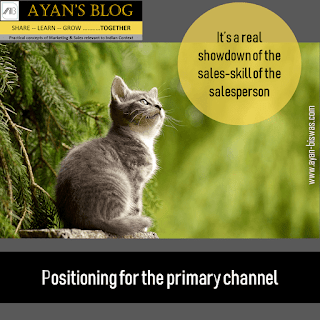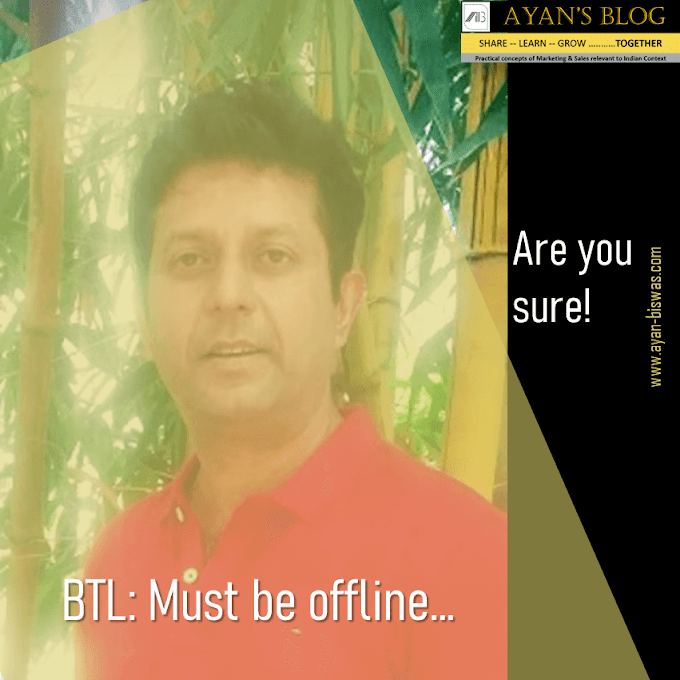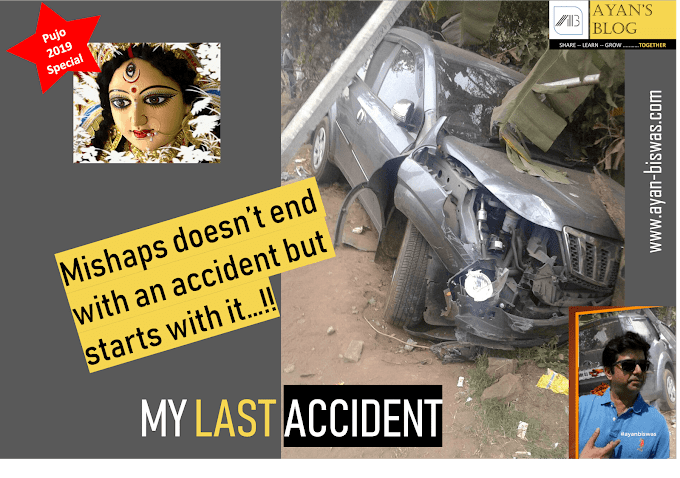In the
previous article, we have discussed in detail about Segmentation-Targeting-
Positioning in Marketing……in this article we would deep-dive into the other
function where STP as a construct is applied.
The other function where STP is used very
frequently is SALES..😲👏
STP in Sales
To have a
better understanding of how the STP in Marketing moves vis-s-vis STP in sales,
we will divide businesses into 3 types namely:
- Distribution based business (offline
& online)
- B2B business (offline & online)
- B2C business (offline & online)
Distribution based business (offline & online)
We will
first discuss the offline model--distribution based business and then move to
the online model-distribution based business.
In the
offline distribution model, to keep it simple & short we take 2 channel
layer….the distributor & the retailer……first layer is the distributor (company bills to the distributor)….2nd layer is the retailer (distributor
bills it to the retailer).
One of the
key role of the sales team in those type of business is to appoint & manage
the distributors. Ask any one from the sales team, they will say it’s one of
the most important job. Do the sales
team follow any STP for distributor appointment…..is it the same as the one
done by the marketing team of the same company……the answer is NO….it’s not the
same..😱wait a second….are we trying to say…the same
company….selling the same product……has different STP done by marketing…..&…..different one
done by Sales…😲😲……Yes…
 |
Segmentation-Targeting-Positioning in Offline Sales
|
The STP done by the marketing team &
STP done by the sales team is different for the same company in distribution
based offline business…😱😨...But why…I
mean……doesn’t that have adverse effect on the business……NO..…it doesn’t have…
Watch the summary snapshot
3 Factor Framework
Main reason for different STP--
- Customers are different — The primary
customers for marketing are end -consumers whereas the primary customers
for Sales are Trade/Channel partners.
- Customer’s objective of Using the
product are different --- The end consumer—Marketing’s primary
customer uses the product for personal use, whereas the Trade/Channel partners—Sales’s
primary customer uses the product for his/her business generation
- Channel---For
Marketing its through traditional media & digital by which it connects with
its customers, for sales it’s primarily face-to-face interaction with its
customers. There are certain exceptions like exhibitions/seminars/meets where
both the Marketing & Sales team connect together with the customer/consumer, but those
are limited numbers compared to day-to-day interactions.
This 3 Factor Framework will
work in maximum of the cases to answer this riddle of how the STP in Marketing
& STP in sales will move vis-à-vis each other...👍
The obvious
question is…..How is the STP done in Sales….!!..
Primary Channel - Segmentation
Segmentation for the primary channel (the channel partner whom the company bills directly...in this case the distributor)
 |
| 3 parameters of Segmentation for a Primary Channel |
Segmentation
is done primarily based on generally 3 parameters:
- Is he from the same industry
- Is he from related industry
- Is he willing to grow or have funds
to invest….the industry experience has less importance here (it’s a more recent
phenomena)
Say for
example , if its lubricant industry…the segments will be in 3 buckets…1st
is he from lubricant industry…2nd..allied industry…which primarily
means auto-ancillary in this case like tires, battery, spare-part, automobile etc.…3rd
from any industry like paint, cement etc. till the time he is willing to grow
& have funds to invest.
Primary Channel - Targeting
Targeting for the primary channel (the channel partner whom the company bills directly...in this case the distributor
 |
| Targeting for a Primary Channel |
Once the
prospective distributors are identified based on the segmentation, targeting is
primarily based on demographics , behavioral , psycho graphic, business
parameters and self-evaluation parameter like:
- Demographic—Income (including
credit in market & investment), Education, Age etc.
- Psycho graphic—Type of personality
he/she has as a business owner (like is he open to experiment, does he
frequently get into the comfort zone etc.), value-system he has etc.
- Behavioral---Loyalty status (how
loyal he has been with the other business/brands he has been operating with,
benefit desired (what is the type of benefit, primarily non-commercial he is
looking for etc.)
- Business Parameter- Current network
strength (His customers- Dealers—Types, Numbers, Relationship with them
etc.…etc.), Other businesses he/she is in, Reputation in the market etc,
commercial terms etc.
- Self-Evaluation—This is probably one
of the most important parameter…here the overall understanding of the sales
person😜 & his corresponding rating of the all the
previous points discussed earlier comes into practice (be rest assured the
data required for the points discussed above like demographic, behavioral etc.
is always not there & even if its there is always not available)
Primary Channel - Positioning
Positioning for the primary channel (the channel partner whom the company bills directly...in this case the distributor)
 |
| Positioning for a Primary Channel |
This is
predominantly the sales skill 👍….the sales guy positions
the company to the prospect based on the requirement of the prospect…(although
the sales person may/mayn’t have a formal corporate presentation with him/her)
he/she highlights those benefits (within the company defined benefits) which
are more relevant to the prospect….for example…for a prospect located in remote
area the benefit highlighted can be service (delivered load—product delivered
directly to distributors’ warehouse from company (plant/depo)….whereas for a
distributor based in metro city the benefit can be added margin which will take
care of the higher operating cost @ metro’s….its a real showdown of the sales-skill of the
salesperson👏😊
The frequency @ which STP is done @ the primary level is continuous but moderate as companies don’t generally make major changes to the primary network frequently
Now lets
have a quick look @ the STP done @ secondary level (retailer/dealer who is
billed by the distributor)
Secondary Channel - Segmentation
Segmentation for the secondary channel (retailer/dealer who is billed by the distributor)
 |
| Segmentation for a Secondary Channel |
This is
done generally both by the company sales team and the distributor/distributor
sales team. The segmentation is done primarily keeping in mind the profile of
business the retailer is in…for example…taking the same example of the
lubricant business….the segments will be lubricant retailers…&…allied
industry retailers like tires, batteries, spare-parts etc. One recent development has been to reach out to retailers who
cater to the same consumer profile….say in case of lubricant
business….reach out to those retailers who has some offering for the
vehicle….so the list now enlarges to car accessory retailers, car paint shops
etc.
Secondary Channel- Targeting
Targeting for the secondary channel (retailer/dealer who is billed by the distributor)
This is the most exhaustive exercise
which the sales team does/supposed to do😉 to ensure higher success rate
 |
| Targeting for a Secondary Channel |
Although,
its dependent on the business type & market, but broadly the elements
discussed here remains the same. The targeting parameters are enlisted below
for a quick glimpse: (it’s generally an excel sheet/software)
- Potential of the retailer (overall
business he does- Your product+ competition product put together)
- Knowledge of competition product—(Brand
wise)- (Product-wise)-(SKU-wise) in terms of:
- Volume & Value
- Price (buying price & selling price)
- Schemes
- Average credit (days & value) Campaigns
- Any other service/offering which is important for retailer’s business
Secondary Channel- Positioning
Positioning for the secondary channel (retailer/dealer who is billed by the distributor)
 |
| Positioning for a Secondary Channel |
The
positioning is decided along with targeting…but generally the sales pitch for
the same is made by the distributor sales representative (DSR). Given the
background of the DSR, its highly imperative that the sales team does the
entire targeting & positioning part religiously, in fact it’s probably one
of the key difference between higher sales & lower sales of the same brand
in nearby markets…😊👍
The key
points covered in it are:
- Retailer
wise plan for increasing share of your business/crack new retailer
- Brand wise)-
(Product-wise)-(SKU-wise) price you want to offer
- Target volume/value of business
with that price
- Proposed scheme
- Campaign/branding you want to offer
to the retailer
- Any other service which needs
mention
Once this
is done, the rest is primarily based on 2 factors:
- Business relationship of the sales
person with the retailer
- The sales skill of the sales-person
The frequency @ which STP is done @ the secondary level is continuous but high as market dynamics keeps on changing & even a new scheme may change retailer buying behavior
Its time
now to have a quick snapshot of the online business of distribution-based
industries. We again go back to the 3 Factor Framework to identify how the STP in Marketing will move as
compared to STP in sales:
- Customer: They are same, as both
marketing & selling is done both online.
- Customer’s Objective: It’s also same
as the customer remains the same person.
- Channel: In maximum cases it’s the
same, although there are examples when there are offline-sales team to connect
face-to-face to the consumer. In majority of the cases, the actual sale
(transaction) still happens online & the one ground sales person is
responsible for the sales pitch.
Hence, in
case of distribution based business—online,, the STP done by the
marketing & STP done by sales team remains almost the same. (which
is in-line with the STP for other-businesses we discussed in the article “STP is only in Marketing-Part-1”
B2B Business (offline & online)
We start
with B2B Business-offline..👍
- Customer—Yes, they are same for both
Marketing & Sales
- Customer’s objective of using the
product—Yes, it’s the same
- Channel- Its not the same. For Marketing its through traditional media
& digital by which it connects with its customers, for sales it’s primarily
face-to-face interaction with its customers. There are certain exceptions like
exhibitions/seminars/meets where both the Marketing & Sales team connect together with the customer/consumer, but those
are limited numbers compared to day-to-day interactions.
Is the Sales STP different from Marketing STP
in this case also…😧😮😯…..Yes…it
is…but the difference is not as big as the one in case of offline distribution
based business….why so…..let’s look @ the 3 Factors Framework again to answer it
So, in case
of B2B--Offline sales, the STP done by Marketing & Sales team is similar
with certain differences
 |
| Segmentation-Targeting-Positioning for B2B Sales |
Segmentation in B2B Sales
This
generally involves identification of the industries in which the product of the
company finds application….for example….if you have are an adhesive making
company…your target segments in B2B space will include those industries where
adhesives finds application…like…book making industries, wood making industries
etc.…similarly if you are into hotel business…probably all industries may fall
under your segment….as both Room-Nights & Banquets are required by all
industries
Once the
segmentation is done, targeting in B2B sales generally involves identifying
customers in those segments and categorizing the customers into A/B/C sometimes
D😆😇 generally based on:
- Conversion status (which part of
the conversion funnel is the customer in…for ex…initial- only one call made, or
higher stage like few calls have been made along with demo, hot pursuit—in
final stages of techno commercial discussion etc. etc.)
- Strategic importance (like in a
current customer I have 90% SOB(Share-of-Business), but in a new project of the
customer which will cater to only 2% of overall volume a tough competition of
mine may make in-roads, I would take that 2% as serious as the current 90% as
competition may slowly start getting into the 90% , once it gets into my
customer with that 2% share because of the new project)
- Convenience (geography, presence of
sales & service team of the company etc. etc.)
- Any other factor which may be of
importance to the business for current/future requirements
Positioning in B2B Sales
There is certain overlap with targeting & few may like to call it more targeting than positioning, but nomenclature doesn’t change the action…😆😄😝…
This is the most important part where the B2B sales person spends the maximum time…its also called Sales plan in some cases…& its reviewed regularly..!!
Its generally done in excel/software, where the key points that are captured target wise i.e. (A/B/C customer group- wise) are:
- Customer Potential- (Volume/Value)
of business along with competition share
- Pricing of competition (wherever
available) along with product details
- Credit details of the competition
- Other details like billing mode,
shipment type etc
- Company contact details—Contact
person (name/ph number/email id), any other person who is involved in the
buying process (decision making process)…his/her credentials
- Any upcoming project of the company
- Proposed product with proposed
commercial terms
- What will the positioning--- what
value will be shown to the customer (within the defined benefits as per the
company policy)
- Remarks which captures the current
status in the conversion funnel & future plan with timeline.
- Any other details which is relevant
for conversion
The frequency @ which the targeting/positioning/sales plan is done by B2B sales team is very high as it continuous update based on the status development of the prospect in the conversion funnel
B2C business (offline & online)
This is a case of direct-to-consumer business…..one big example of this is majority of the start-ups that we see around….like food-tech, edu-tech, e-mobility etc are examples of this B2C online business model…😀👍.&…Insurance agents are a big example of B2C offline sales. Lets quickly jump to the 3 Factor Framework to identify how the STP in Marketing will move as compared to STP in sales
- Customer: They are same, as both
marketing & selling is done both online
- Customer’s Objective: It’s also same
as the customer remains the same person
- Channel: In maximum cases it’s the
same, although there are examples when there are offline-sales team to connect
face-to-face to the consumer. In case of B2C offline model, the actual sale
(transaction) still happens offline & in case of B2C online model maximum of
the cases, the sale happens online & the sale team on-ground is responsible
for sales pitch & facilitation, in some cases
Hence, in case of B2C (online & offline) business, the STP done by the marketing & STP done by sales team remains almost the same
C😄😄L if you have read 👆
Will be C😄😄😄LER if you comment👇
Will be C😄😄😄😄LEST if you


















0 Comments
Would love to hear from you, know your thoughts on this write up
Emoji